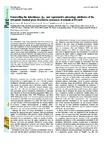Please use this identifier to cite or link to this item:
http://www.alice.cnptia.embrapa.br/alice/handle/doc/1061767| Title: | Unravelling the inheritance, Qst and reproductive phenology attributes of the tetraploid tropical grass Brachiaria ruziziensis (Germain et Evrard). |
| Authors: | RESENDE, R. M. S.  VALLE, C. B. do   RESENDE, M. D. V.   |
| Affiliation: | ROSANGELA MARIA SIMEAO RESENDE, CNPGC; CACILDA BORGES DO VALLE, CNPGC; MARCOS DEON VILELA DE RESENDE, CNPF. |
| Date Issued: | 2017 |
| Citation: | Plant Breeding, v.136, n.1, p. 101-110, Feb. 2017. |
| Description: | The autotetraploid forage Congo signal grass (Brachiaria ruziziensis) is an important component in the Brachiaria breeding programme. As with other tropical forage grass species, the association between flowering and seed yield components, the mode of inheritance and the effects of population structure on phenotypic breeding are lacking. Seventeen characteristics evaluated in 59 half-sib progeny of seven subpopulations were analysed using a mixed model methodology. According to the commonality analysis, the total seed yield (0.67) and number of days to flowering (0.22) had a greater influence on the filled-seed yield. The flowering synchrony, total number of panicles, filled-seed yield, green matter yield and dry matter yield presented statistically significant additive genetic variance between and within the subpopulations. The QST estimates ranged from 0.09 for the flowering synchrony index to 0.31 for the filled-seed yield. The effects of population structure and its use in breeding programmes are further discussed. |
| NAL Thesaurus: | Flowering Genetic correlation Heritability Population Progeny testing Seed yield |
| Keywords: | Commonality Synchrony index |
| Type of Material: | Artigo de periódico |
| Access: | openAccess |
| Appears in Collections: | Artigo em periódico indexado (CNPGC)  |
Files in This Item:
| File | Description | Size | Format | |
|---|---|---|---|---|
| unravellingtheinheritance.pdf | 572,26 kB | Adobe PDF |  View/Open |









